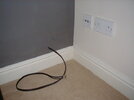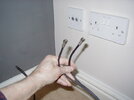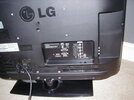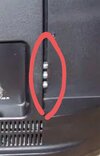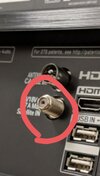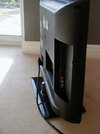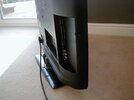To summarise where you're at so far in the thread.
Why two cables? - There are two cables with the screw-on connectors because that's how a Sky box or Freesat recorder works. It needs two feeds to allow the watching of one channel whilst recording one or more other channel(s) at the same time.
A simple Freesat or satellite TV tuner (they're not that same thing) is a
watch-one-channel-only, no-recording device. This is the case with a lot of TVs that used to have satellite or Freesat reception. They need just one connection because you'll rarely be doing anything more than watching one channel as it is broadcasting. If recording is an option - and don't take it as granted that it is - then you're stuck with watching the channel that is being recorded.
Personally I would find this too limiting. I'm used to the PVR functions of a dual or multiple channel recorder. I want to be able to pause live TV and to set recordings without worrying whether someone else will try to change channel half way through and ruin it. YMMV.
We don't get Freeview reception here - You have what looks like a fairly new-build house. It may well be in a location that doesn't get Freeview, or the signal is marginal. Freeview covers 98.5% of the UK population, but that sill leaves around 350,000 households in the UK where coverage is poor or just doesn't exist. However, don't take it for granted that you're in one of those places.
New estates often have a restriction on outdoor aerial installations until after all the plots are sold. The housebuilder wants everything to look nice and neat. The thinking is outdated, but the restrictions still exist. Secondly, house builders are crap at anything to do with aerial installations and their wiring. I can't tell you how many times I have been to jobs where the sockets are wired wrong and that stops or at least reduces reception. It's frighteningly common to find the things bodged.
Next, the builders do not install aerials in the lofts. They just leave the cables coiled up, sometimes hidden under the loft boarding, and so the first game is 'hunt the cable'. If you are being told that there's little to no Freeview reception where you are then it could be that the person telling you is a DIYer with no real aerial knowledge. They tried it, and couldn't get an immediate result because of some other issue, so they gave up without further investigation. Other common occurrences are that satellite installations are allowed (but not aerials - go figure) and so everyone follows suit. The assumption then is "
Oh, everyone has Sky round here" and that becomes "
there's no Freeview reception" without any proper validation. This is what
@flameport said (post #6) I've even had it where someone has tried all the aerial sockets in the house and go no reception, but they never bothered to check if there's an aerial attached at the other end... and there isn't.
Another common fault is that an aerial has been fitted by a previous owner, but it needed amplification because of the bad wiring to the aerial sockets or the loft location. The power for this was a little box - looked like a booster behind one of the TVs - and so when the previous owners moved they too that with them. No power supply = no power to the amplified splitter = no signal for the new home owners.
The point here is that unless you're hearing that there's no Freeview reception from a couple of reputable local aerial fitters, then take anything the neighbours say with a pinch of salt. They are not experts.
"Where to connect these cables to the sockets on my TV?" - Your LG TV doesn't have a satellite signal input. If it did, there'd be threaded connector marked SAT or something similar. [See the second image in post #2 from
@RandomGrinch. He circled the connection on his TV.] Your TV doesn't have that, and it means there's no suitable tuner within the TV for satellite/Freesat reception.
Normally at this point the next question is "
can I get an adapter?". The answer to that is no. This isn't a case of changing the sex or design of the plug end to fit. The satellite signals running through the cable are different to Freeview. They're a different language, if you will. You need a box or receiver that speaks satellite, and that would be a satellite receiver.
"
How many cables do I connect?" - for a watch-live satellite or Freesat receiver you need just one connection. The other cable is redundant at that point. It doesn't matter which cable you use, but it would be prudent to test both. Where you want a Freesat recorder, then you'll need both connections. As
@foxhole said (post #3), get a Freesat box, plug in the lead(s), then connect a HDMI cable from the box to the TV.
-------- Questions you haven't asked yet --------
Freesat vs just satellite - Freesat is part of the UKs digital TV platform, and so the channel layout is similar to Freeview i.e. it goes BBC-1, BBC-1 ITV, C4, Ch5 and so on. All Freesat receivers adhere to this. There's also continuity with the TV guide and certain other features. The alternative is simply
satellite reception. This is a bit like the wild west frontiers. Anything goes. There are lots of satellites up in a geostationary orbit, and several of their transmission zones overlap on the UK. You'll pick up the channels that you would with Freesat, but also a whole bunch of other stuff, mostly foreign language and subscription channels. If you opt for a simple satellite receiver then it's up to you to manage and curate the channel listings and keep them up-to-date if they change.
Freesat vs Freeview - several points here:
• Freesat has more HD channels than Freeview. All the main BBC and ITV channels available in HD will be on Freesat. Fewer of the SD versions
• You will need cabling and a Freesat receiver for every TV you want to use for live TV viewing. Freeview (the aerial one) is simpler and cheaper to distribute throughout your home. Every TV has a Freeview tuner.
• Freesat receivers: three manufacturers; Manhatten (basic receivers), Humax (no longer manufacturing, but some dual input recorders are available as refurbs and second-hand), Arris, the current holder of the Freesat supply contract. Anything current that isn't a Manhatten will be an Arris box. You'll see 'Freesat 4K'. There are no 4K TV transmissions on Freesat The 4K bit refers to streaming apps such as Netflix, BBC iPlayer etc. The boxes will stream in 4K


